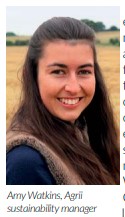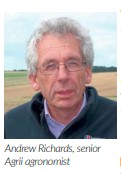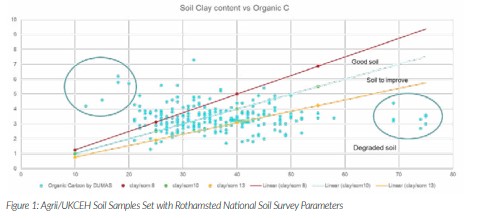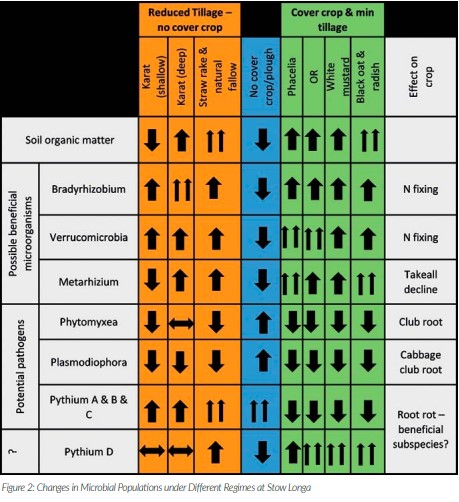How can I reduce tillage without adding to my risk? What are the best ways of cutting my vulnerability to the weather?
How much carbon can I realistically capture? What do I need to do to achieve the most rewarding SFI soil standards?
Where should I focus my improvement efforts for the greatest overall value?
These are just a few of the practical questions the Green Horizons Soil Resilience Strategy launched this spring by national agronomy leader, Agrii is designed to answer. And, in so doing, help East Anglian growers improve the resilience of their soils and sustainability of their systems. Developed following studies with the UK Centre for Ecology & Hydrology (UKCEH) and others, the strategy pulls together the latest understanding of soil structure, chemistry and biology. It provides a carefully structured approach to improving soil resilience based on the best available science, a thorough understanding of soil management, and sound practical advice and action. Flexible packages of laboratory and field-based assessments are designed to suit every soil condition, farming system and farm need, with an expanding team of soil management advisers providing specialist support.

“Our strategy employs a range of modern lab tests and hands-on, infield appraisals to identify the current health of farmed soils,” explained Agrii s u s t a i n a b i l i t y manager, Amy Watkins at the Cambridgeshire launch.
“Together with a good understanding of each farm’s particular objectives, needs and resources and practical soil management intelligence, these enable us to work with growers to develop the most appropriate plans of progressive improvement action.
“As well as concentrating the attention on some of the best areas for and ways of improving both immediate farm productivity and long-term sustainability, our strategy provides an ideal foundation for making the most of the evolving SFI soil standards payments.”
Provided through both Agrii agronomists and Rhiza specialists, the Green Horizons Soil Resilience Strategy (SRS) starts with a thorough soil health assessment involving broad spectrum laboratory nutrient, pH and organic matter testing. To which can be added more detailed measurements of soil carbon at different depths. Alongside this, it offers a suite of infield soil biology, structure and water management assessments, employing standardised methodologies for worm activity monitoring, Visual Evaluation of Soil Structure (VESS), penetrometer, slake, aggregate stability and infiltration testing.
Carried out on a sample of fields representative of the farm as a whole or those posing particular management concerns – depending on individual preferences – the results of all these assessments are set out in easy-tounderstand reports. The Agrii team accepts that much remains to be fully understood about soil biology, the best ways of measuring it, and its complex interactions with soil structure and chemistry. So, their approach has been designed for the greatest flexibility in responding to future advances in the science as well as in meeting the individual needs of different growers and systems, not to mention changing legislation and agricultural support. Appreciating there is no ideal soil biological community, it sets out to assess the most practical indicators of all-round soil health and productivity available as benchmarks for planning and monitoring improvements over time.
“Capturing the detail of all our assessments in the standard field reports we have developed to present the results in the clearest and most practical way provides the best basis for benchmarking and improvement planning,” Amy Watkins said. “Our reports give an objective and scientifically-valid record of soil status, allowing individual farm teams to set realistic objectives for improvement; monitor their success in meeting them; and (increasingly importantly for the future) demonstrate their progress to others – be they customers, carbon offsetters, agricultural support providers or the general public.”
“To encourage the widest possible participation, we have kept SRS charges at standard consultancy and laboratory rates as reasonable as we can,” she stressed. “The individual cost will, of course, depend on the specific assessments selected, the number of fields included and the frequency of retesting.”
Scientific Understanding for
Practical Action

While its lab and field assessments produce a raft of b e n c h m a r k i n g data, the real value of the Green Horizons Soil Resilience Strategy is in the practical action plans it develops from them rather than what they actually show, stressed senior Agrii agronomist, Andrew Richards at the launch. Playing a leading role in developing the science behind the Strategy over the past five years, Mr Richards is adamant that only by combining a detailed understanding of each grower’s resources and objectives with the best intelligence on all aspects of soil health and its management can any findings be translated into the most appropriate improvement action.
“More fundamental soil health constraints like pH, for instance, need to be addressed before it’s worth you doing much else,” he insisted. “Equally, moving to direct drilling without making sure your ground is ready for it could easily jeopardise performance. And it is essential to target levels of organic matter improvement that are realistic for both your soils and farming system. “While no single metric can capture the sheer complexity of soil health, the best science suggests soil carbon offers an essential, simple way to assess it. But this has to be done with an understanding of how soil structure affects its carbon-carrying content. “Our work with UKCEH has assessed the detailed organic content at DNA level of soils from almost 400 main southern England fields under a wide variety of management regimes. Amongst other things, this has shown that the clay:carbon ratio of soils is a much more useful measure of their resilience than organic matter alone. Because clay particles bind organic matter, the greater the clay content of a soil the more organic carbon it can store, but the higher the level it will require to be resilient and the slower it will be to build.
“So, we have made this metric central to our approach. Only by establishing exactly where soils sit on the clay:carbon resilience scale developed from Rothamsted work with the national soil survey, can we provide the most practical recommendations for both soil health and soil carbon storage improvements. (Figure 1).
Although the clay:carbon ratio is considered to provide one of the best available baseline measures of soil resilience status, soil organic matter changes only very slowly. So, Andrew Richards points out that merely monitoring changes in this parameter is not going to be enough to indicate progress – or lack of it – in improving soil functioning. “Which is why our drive to improve soil resilience also involves a range of other soil physical, chemical and biological assessments,” he said. “In our Visual Evaluations of Soil Structure (VESS) we record primary and extended root penetration depths and arbuscular mychorrhiza as well as soil plasticity, mottling and aggregation. We take penetrometer readings throughout the profile; carry out highly visual infiltration tests; and assess the type and activity as well as number of earthworms. Active carbon measurements are another useful tool alongside other laboratory tests.
“Taken together, these assessments enable us to establish exactly how resilient particular soils are and suggest the most profitable avenues for their improvement. This and a detailed understanding of each farm’s particular needs and constraints go into our action plans, the success of which we then monitored by careful re-assessment to the same protocols.

Key Soil Resilience
Assessment Considerations
Extensive Agrii trialling and onfarm testing over several years have identified a host of critical considerations in both assessing soil resilience and using these assessments to improve it. Most importantly:
• Selecting fields carefully on the basis of individual grower needs;
• Taking samples that are as representative as possible of field status;
• Making biological assessments at the best time, preferably in the spring;
• Recording the weather at the time of each assessment;
• Basing all organic matter testing on the same proven process (preferably DUMAS);
• Adjusting for bulk density, chalk and stone content for accurate carbon accounting;
• Following up in-depth initial assessments with seasonal snapshots;
• Re-testing every 3-5 years – ideally with active carbon monitoring in between;
• Making future assessments at the same time of the year and under similar conditions;
• Knowing the cultivation and cropping history of the fields assessed; and,
• Understanding the particular objectives and constraints of the farm.
Managing the Soil
Microbiome
Detailed UK Centre for Ecology & Hydrology UKCEH genetic barcoding work with the heavy land soil at Agrii’s Stow Longa technology centre has shown the encouraging extent to which its microbial communities have been influenced by different cultivation and cover cropping regimes run side-by-side under carefully controlled conditions over just three years. Altogether, the microbiologists identified an impressive 62,000 different bacteria, 2000 different fungi and 4000 different eukaryotes in the Stow Longa microbiome.
Irrespective of the marker genes they used, they recorded large differences in the communities of all three types of microbe between the cultivation and cover cropping treatments. These were clearly associated with changes in organic matter level. The degree of cultivation also appeared to be a factor, with the communities under a straw raking regime being similar to those under the various cover crops and distinctly different from those under either shallow or deep tillage.
The studies showed noticeable improvements in organic matter with both reduced cultivations and cover cropping. Even more interestingly, perhaps, increases in organic matter and decreases in soil disturbance were found to be associated with higher populations of potentially beneficial micro-organism indicators and lower populations of those considered to be harmful (Figure 2).
